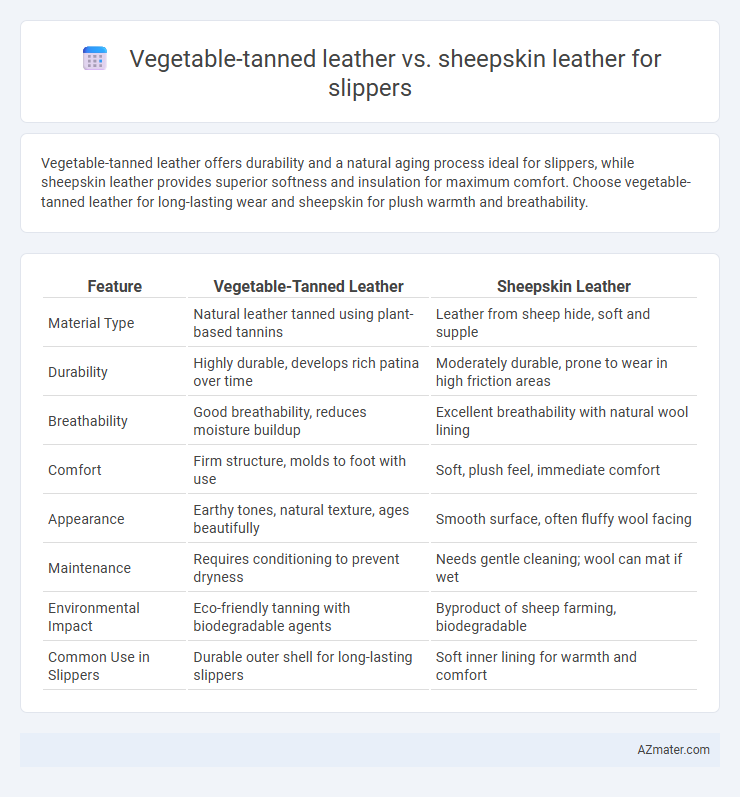Vegetable-tanned leather offers durability and a natural aging process ideal for slippers, while sheepskin leather provides superior softness and insulation for maximum comfort. Choose vegetable-tanned leather for long-lasting wear and sheepskin for plush warmth and breathability.
Table of Comparison
| Feature | Vegetable-Tanned Leather | Sheepskin Leather |
|---|---|---|
| Material Type | Natural leather tanned using plant-based tannins | Leather from sheep hide, soft and supple |
| Durability | Highly durable, develops rich patina over time | Moderately durable, prone to wear in high friction areas |
| Breathability | Good breathability, reduces moisture buildup | Excellent breathability with natural wool lining |
| Comfort | Firm structure, molds to foot with use | Soft, plush feel, immediate comfort |
| Appearance | Earthy tones, natural texture, ages beautifully | Smooth surface, often fluffy wool facing |
| Maintenance | Requires conditioning to prevent dryness | Needs gentle cleaning; wool can mat if wet |
| Environmental Impact | Eco-friendly tanning with biodegradable agents | Byproduct of sheep farming, biodegradable |
| Common Use in Slippers | Durable outer shell for long-lasting slippers | Soft inner lining for warmth and comfort |
Introduction to Leather Types for Slippers
Vegetable-tanned leather offers durability and a natural aging process, making it ideal for high-quality slippers that develop character over time. Sheepskin leather provides exceptional softness and insulation, ensuring comfort and warmth in indoor footwear. Choosing between these leathers depends on the desired balance of longevity, breathability, and tactile comfort for slippers.
What is Vegetable-Tanned Leather?
Vegetable-tanned leather is crafted using natural tannins extracted from tree bark, leaves, and other plant materials, resulting in a durable and eco-friendly material renowned for its ability to develop a rich patina over time. This tanning method offers superior breathability and firmness ideal for slippers, ensuring long-lasting shape retention and comfort. Compared to sheepskin leather, which is soft and supple but less structured, vegetable-tanned leather provides enhanced durability and a distinctive earthy aroma that appeals to environmentally conscious consumers.
Understanding Sheepskin Leather
Sheepskin leather offers exceptional softness and natural insulation, making it ideal for slippers that prioritize comfort and warmth. Unlike vegetable-tanned leather, which is firm and develops a patina over time, sheepskin leather features a supple texture and breathability due to its fine grain and wool fibers. This unique combination ensures slippers made from sheepskin leather provide a cozy, breathable environment, perfect for indoor wear.
Durability: Vegetable-Tanned vs Sheepskin Slippers
Vegetable-tanned leather slippers offer superior durability due to their dense fiber structure and natural tanning process, which enhances resistance to wear and aging. Sheepskin leather slippers provide excellent softness and insulation but are generally less durable, as the softer hide is more prone to stretching and abrasion over time. For long-lasting slipper use, vegetable-tanned leather delivers greater resilience against daily wear compared to the more delicate sheepskin material.
Comfort and Feel Comparison
Vegetable-tanned leather offers a firmer, more durable feel that molds gradually to the foot, providing long-lasting support and breathability ideal for slippers. Sheepskin leather delivers an exceptionally soft, plush texture with natural insulating properties, ensuring immediate comfort and warmth. The choice between the two depends on whether one prioritizes structured comfort with aging character or a cozy, cushioned slipper experience.
Breathability and Moisture Control
Vegetable-tanned leather offers superior breathability due to its porous structure, allowing air to circulate and reduce moisture buildup inside slippers. Sheepskin leather features a natural wool lining that excels at moisture absorption and wicks sweat away, maintaining a dry and comfortable environment for feet. Both materials enhance moisture control, but vegetable-tanned leather is ideal for ventilation, while sheepskin provides exceptional humidity regulation and softness.
Environmental Impact and Sustainability
Vegetable-tanned leather for slippers is more environmentally sustainable due to its natural tanning process using plant-based materials, which reduces harmful chemical waste and lowers water pollution compared to chrome-tanned methods. Sheepskin leather, while soft and comfortable, typically involves energy-intensive processing and chemical treatments that contribute to higher environmental footprints. Choosing vegetable-tanned leather supports eco-friendly practices by minimizing toxic byproducts and promoting biodegradability, making it a preferable option for sustainable footwear.
Aesthetics and Aging Characteristics
Vegetable-tanned leather offers a rich, natural patina that deepens and enhances the slipper's aesthetics over time, showcasing unique color variations and texture shifts. Sheepskin leather maintains a soft, supple feel with a more uniform appearance but tends to develop gentle creases and mild aging signs without significant color change. Both materials provide distinct aging characteristics, with vegetable-tanned leather favoring a rugged, vintage look, while sheepskin emphasizes consistent softness and comfort.
Price Difference and Value
Vegetable-tanned leather slippers typically cost more due to the eco-friendly, time-intensive tanning process that enhances durability and develops a rich patina over time. Sheepskin leather slippers are often priced lower and provide exceptional softness and insulation but may wear out faster and require more maintenance. The value of vegetable-tanned leather lies in its long-lasting strength and natural aging characteristics, while sheepskin leather offers immediate comfort and warmth at a more affordable price point.
Best Choice: Which Leather for Your Slippers?
Vegetable-tanned leather offers durability, breathability, and develops a unique patina over time, making it ideal for long-lasting slippers with natural aging. Sheepskin leather provides superior softness, insulation, and moisture-wicking properties, ensuring comfort and warmth in slippers, especially for colder climates. Choosing between vegetable-tanned and sheepskin leather depends on whether durability and aging or softness and warmth are your primary priorities for slipper performance.

Infographic: Vegetable-tanned leather vs Sheepskin leather for Slipper
 azmater.com
azmater.com